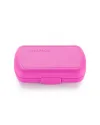















 Swiss premium oral care
Swiss premium oral care
 United Arab Emirates
United Arab Emirates

Sugar and spice and all things nice.
Variants
Sugar and spice and all things nice.

Eye-catching, colourful design

Comprehensive travel care set

Lightweight and easy to carry

Eye-catching, colourful design

Comprehensive travel care set

Lightweight and easy to carry
25% OF ALL SALES OF THIS PRODUCT GO TO THE PINK RIBBON FOUNDATION TO SUPPORT THEM IN THE WONDERFUL WORK THEY DO RAISING AWARENESS FOR BREAST CANCER.
CHOOSE WISELY, WHEREVER YOU GO.
An exceptional, compact travel toothbrush, 10ml zesty fresh whitening toothpaste and two interdental brushes with a handy holder. The ultimate Curaprox oral health care.
No compromise on style. No compromise on oral health. Your favourite Curaprox products in your suitcase, your hand luggage – or in your pocket. This vibrant, stylish travel kit measures just 9.5 cm x 6 cm.
Contains:
● CS 5460 travel toothbrush: Relentless on plaque. Relentlessly gentle on your teeth and gums
● Curaprox Be you toothpaste Challenger Gin Tonic + Persimmon, 10ml: Protects and cares for teeth and gums. Gently and effectively whitens
● CPS prime interdental brushes, size 07-red & 09-yellow: Effective brushing in the spaces between your teeth
Ingredients:
Aqua, Glycerin, Hydrated Silica, Sorbitol, Xylitol, Panthenol, Aroma, Sodium Monofluorophosphate, Xanthan Gum, Cocamidopropyl Betaine, Microcrystalline Cellulose, Decyl Glucoside, Maltodextrin, Hydroxyapatite (nano), Glucose Oxidase, Mannitol, Mica, Sucralose, Citric Acid, Sodium Hydroxide, Zea Mays Starch, Glucose, Echinacea Purpurea Root Extract, Titanium Dioxide, Sodium Chloride, Sodium Metabisulfite, Calcium Carbonate, L-Menthol, Centella Asiatica Extract, Citrus Aurantium Amara Fruit Extract, D-Limonene, Potassium Thocyanate, Polylysine, Eugenol, Cetyl Alcohol, Silica, Potassium Chloride, Tin Oxide, Harpagophytum Procumbens Root Extract, CI 73360
 Swiss premium oral care
Swiss premium oral care

